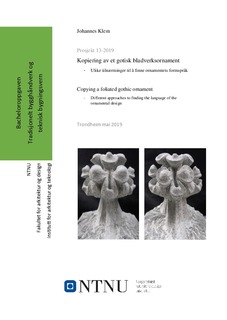| dc.contributor.advisor | Haupt, Thomas | |
| dc.contributor.advisor | Hakonsen, Finn | |
| dc.contributor.author | Klem, Johannes | |
| dc.date.accessioned | 2019-09-05T14:01:57Z | |
| dc.date.available | 2019-09-05T14:01:57Z | |
| dc.date.issued | 2019 | |
| dc.identifier.uri | http://hdl.handle.net/11250/2612808 | |
| dc.description.abstract | Sammendrag
Den utvendige ornamentikken av Nidarosdomen og andre gotiske katedraler er veldig intrikat, men også skjør og sårbar. Stadig utsatt for vær og vind trenger den stadig vedlikehold og fornyelse.
Dagens restaurering preges mer og mer av forskjellige teknologiers innsats. Bruken av mekaniske instrumenter som punkteringsapparatet kan ses som et tidlig skritt mot en helt maskindreven reproduksjon av steinornamenter. Den originale prosessen drevet av håndverkerens skaperånd synes å bli mindre og mindre viktig.
Ved å utføre forskjellige formings- og kopieringsmetoder har jeg prøvd å finne ut på hvilken måte disse prosessene påvirker det endelige resultatet og hvilke konsekvenser det har for meg som håndverker. For å støtte mine funn og konklusjoner har jeg studert teoriene og tankene til 1800-tallets store engelske kunstteoretiker John Ruskin.
Å komme frem til en objektiv konklusjon hvilken av metodene som er den best egnede er veldig vanskelig. Ulike aspekter, omstendigheter og meninger må tas i betraktning og diskuteres. Men, fra mitt personlige standpunkt ville et større fokus på steinhuggingens skapende og formende aspekt tilført prosessen betydelige kvaliteter: Hvis ornamentet ikke bare var en kopi, men hvis den, til et visst punkt, også hadde noe av ånden til dagens steinhugger, så ville steinen være en mer ærlig, og i denne forstand også mer «original» bidrag til katedralens bygningshistorie. I tillegg kunne et slikt fokus bidratt til en sterkere anerkjennelse og revitalisering av det tradisjonelle håndverksfaget «steinhugging». | |
| dc.description.abstract | Abstract
The exterior ornamentation of Nidaros Cathedral in Trondheim as with other gothic cathedrals is very intricate, but also frail and vulnerable. Constantly exposed to the destructive forces of the wind and weather it needs constant maintenance and renewal.
In the present-day restoration of historic monuments technology has become more and more important. The use of mechanical copying devices like the pointing machine can be seen as an early step towards a totally machine-driven reproduction of stone ornaments. The original crafting process driven by a creative spirit seems to become less and less important.
By practising different forming and copying methods, I have tried to find out in which way these processes affect the appearance of the final result and which consequences this might have for my own craftsmanship. To support my findings I have engaged myself predominantly in the theories and thoughts of the English 19th century art critic John Ruskin.
Coming to an objective conclusion as to which copying method might be the most appropriate is a very difficult matter. Various aspects, circumstances and opinions have to be considered and discussed. However, from my personal point of view a stronger focus on the creative aspect of stone carving would add significant qualities to the process: Being not just a copy of a former stone, but also carrying to some extent the spirit of the present-day carver, the ornament could be a more honest, and in that sense more “original” contribution to the cathedral’s building history. Additionally, such a focus could lead to a stronger appreciation and revitalisation of the traditional craft of stone carving. | |
| dc.language | nob | |
| dc.publisher | NTNU | |
| dc.title | Kopiering av et gotisk bladverksornament - Ulike tilnærminger til å finne ornamentets formspråk | |
| dc.type | Bachelor thesis | |
